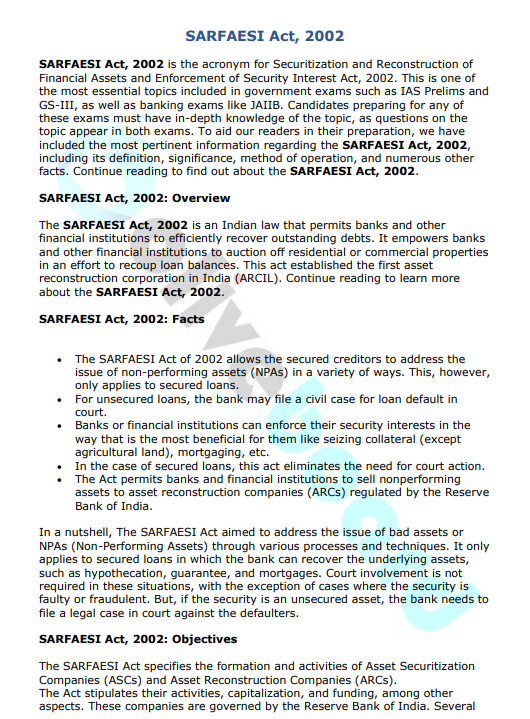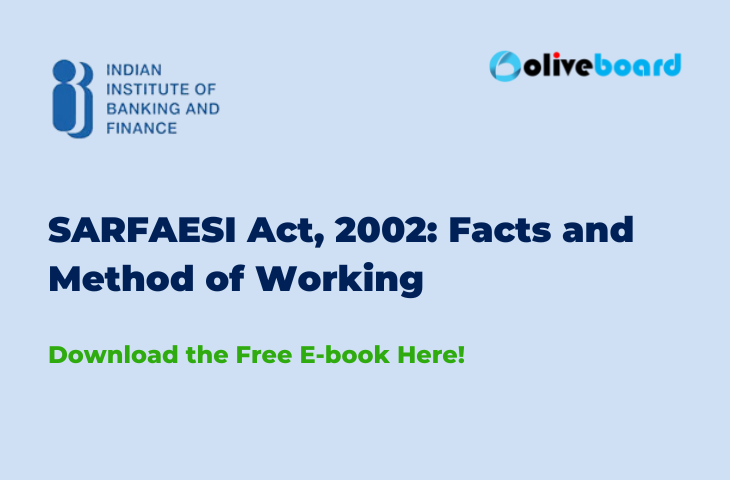SARFAESI Act, 2002 is the acronym for Securitization and Reconstruction of Financial Assets and Enforcement of Security Interest Act, 2002. This is one of the most essential topics included in government exams such as IAS Prelims and GS-III, as well as banking exams like JAIIB. Candidates preparing for any of these exams must have in-depth knowledge of the topic, as questions on the topic appear in both exams. To aid our readers in their preparation, we have included the most pertinent information regarding the SARFAESI Act, 2002, including its definition, significance, method of operation, and numerous other facts. Continue reading to find out about the SARFAESI Act, 2002.
Download SARFAESI Act, 2002: Facts and Method of Working E-Book
Download SARFAESI Act, 2002: Facts and Method of Working free e-book
How to Download SARFAESI Act, 2002: Facts and Method of Working E-book for JAIIB?
Step 1: Click on the download link. You will be redirected to Oliveboard’s FREE E-Books Page.

Step 2: Create a free Oliveboard account or login using your existing Oliveboard account details
Step 3: Download the book by clicking on the link presented on the page.
Introduction
The SARFAESI Act, 2002 is an Indian law that permits banks and other financial institutions to efficiently recover outstanding debts. It empowers banks and other financial institutions to auction off residential or commercial properties in an effort to recoup loan balances. This act established the first asset reconstruction corporation in India (ARCIL). Continue reading to learn more about the SARFAESI Act, 2002.
SARFAESI Act, 2002: Facts
- The SARFAESI Act of 2002 allows the secured creditors to address the issue of non-performing assets (NPAs) in a variety of ways. This, however, only applies to secured loans.
- For unsecured loans, the bank may file a civil case for loan default in court.
- Banks or financial institutions can enforce their security interests in the way that is the most beneficial for them like seizing collateral (except agricultural land), mortgaging, etc.
- In the case of secured loans, this act eliminates the need for court action.
- The Act permits banks and financial institutions to sell nonperforming assets to asset reconstruction companies (ARCs) regulated by the Reserve Bank of India.
In a nutshell, The SARFAESI Act aimed to address the issue of bad assets or NPAs (Non-Performing Assets) through various processes and techniques. It only applies to secured loans in which the bank can recover the underlying assets, such as hypothecation, guarantee, and mortgages. Court involvement is not required in these situations, with the exception of cases where the security is faulty or fraudulent. But, if the security is an unsecured asset, the bank needs to file a legal case in court against the defaulters.
SARFAESI Act, 2002: Objectives
The SARFAESI Act specifies the formation and activities of Asset Securitization Companies (ASCs) and Asset Reconstruction Companies (ARCs).
The Act stipulates their activities, capitalization, and funding, among other aspects. These companies are governed by the Reserve Bank of India. Several sections of the Act provide institutions with directives and authority to tackle the problem of problematic assets. The following are the primary objectives of the SARFAESI Act, 2002.
- The Act establishes the legal foundation for securitization in India.
- It outlines the processes for transferring NPAs to ARCs (Asset Reconstruction Companies) for the purpose of asset reconstruction.
- The Act enables the banks and financial institutes to enforce their security interest without the intervention of the court.
- It grants them the authority to seize immovable property that has been hypothecated or billed in order to recover the debt.
SARFAESI Act, 2002: Method of Working
The primary characteristic of SARFAESI is that it encourages the formation of asset reconstruction companies (ARCs) and asset securitization companies (ASCs) to manage NPAs collected by financial institutions and banks. The Act provides three major powers to financial institutions and banks for the asset management and recovering non-performing assets:
- Securitization of assets
- Reconstruction of assets
- Enforcement of security interests (meaning asset security interests) without the court’s intervention
To better understand the SARFAESI Act, let’s first understand the meaning of these terminologies.
Securitization
Securitization is the process of converting existing illiquid assets (loans) into marketable securities in the setting of poor asset management.
The securitization company assumes custody of the loan applicant’s underlying mortgaged assets. It can initiate the subsequent actions:
- Purchasing financial assets from the loan provider (bank), and
- The solicitation of funds from authorized institutional buyers through the issuance of security receipts for acquiring the financial assets, or
- Fundraising in any authorized manner, and
- The acquisition of a financial asset may be paired with the repossession of mortgaged property, structures, etc.
Asset Reconstruction
Reconstructing an asset is the process of transforming a bad asset or NPA into a performing asset. The process includes a number of steps, such as the purchase of a bad asset by an asset reconstruction company (ARC), the financing of the process of bad asset conversion into a good asset utilizing debentures, bonds, cash, or securities, and the fulfilment of returns from the hypothecated assets, etc.
Since reconstruction must be carried out in compliance with RBI standards, the SARFAESI Act, 2002 specifies the elements for the asset reconstruction, which are as follows:
- taking over or altering the management of the borrower’s business
- the sale or lease of all or a portion of the borrower’s enterprise
- the postponement of the borrower’s loan payments
- enforcement of a security interest according to the terms of the Act
- payment of debts owed by the borrower
- taking possession of assets according to the norms of the Act
Take a peek at SARFAESI Act, 2002: Facts and Method of Working E-book

Conclusion
The SARFAESI Act, 2002 has been extensively covered in this article to help our readers prepare for their exams. We encourage them to study diligently, thoroughly covering all of the exam’s topics to score well in the competitive exams.
FAQs
A. According to the SARFAESI Act of 2002, the securitization transaction must be registered with the Registrar of the Central Registry.
A. According to the SARFAESI Act, 2002, enforcement of security interest implies the sale of collateral without court intervention by the secured creditor.
JAIIB Study Material Compilation
Also Read:
- JAIIB Exam Analysis 2022 I Paper 2 – AFB I Feb 2022
- JAIIB Exam Analysis 2022 I Paper 1 – PPB I Feb 2022
- Preparation Tips for JAIIB Exam- Last Minute Strategy
- JAIIB Revision Plan- Last 10 Days Plan
- JAIIB Frequently Asked Questions- 2022| Check Here (oliveboard.in)
- JAIIB Genius | JAIIB Weekly Quiz PDF – JAIIB Questions PDF (oliveboard.in)
- JAIIB Full Form – Junior Associate of the Indian Institute of Bankers (oliveboard.in)
- JAIIB and CAIIB Books- Exams Syllabus, Books, and more (oliveboard.in)
Also Check:
- JAIIB 2022 Exam -Notification Released (oliveboard.in)
- JAIIB Notification 2022 – Notification PDF, Eligibility, (oliveboard.in)
- JAIIB Apply Online – Application Form 2022, Fees, Instru (oliveboard.in)
- JAIIB Eligibility – Age, Degree, Nationality, Members (oliveboard.in)
- JAIIB Syllabus – Complete List of Papers, Modules (oliveboard.in)
- JAIIB Exam Pattern 2022 – Details of Pattern, Marking (oliveboard.in)
- JAIIB Admit Card November 2022 – Steps and Direct Download (oliveboard.in)
- JAIIB 2022 Cut Offs – Check JAIIB Minimum Cut Off (oliveboard.in)

Hello there! I’m a dedicated Government Job aspirant turned passionate writer & content marketer. My blogs are a one-stop destination for accurate and comprehensive information on exams like Regulatory Bodies, Banking, SSC, State PSCs, and more. I’m on a mission to provide you with all the details you need, conveniently in one place. When I’m not writing and marketing, you’ll find me happily experimenting in the kitchen, cooking up delightful treats. Join me on this journey of knowledge and flavors!
